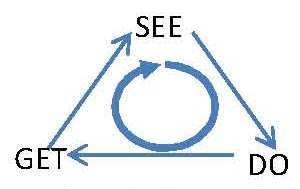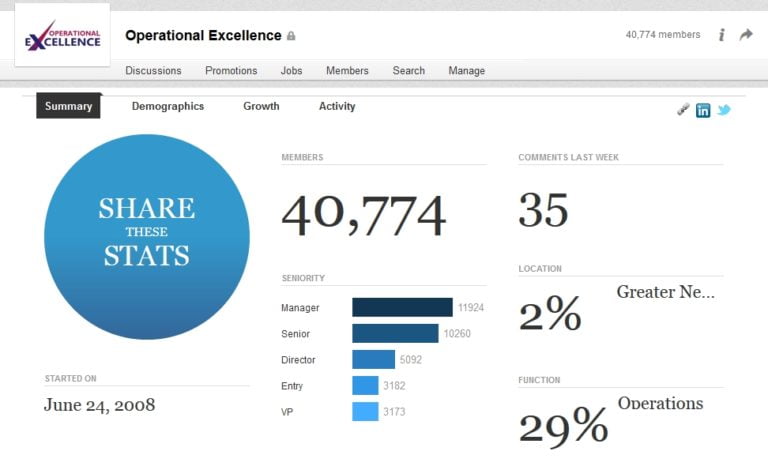‘Soft Stuff’ has EVERYTHING to do with Bottom Line
What separates an effective organization from an organization that just shifts from one management fad to another? Substance vs. Form. In a high-performance organization, one can never successfully sell the ‘soft stuff’, the latest management concepts, or the latest technology on their own merits. One has to make the connection to the financial bottom line. The intent of this article is to increase readers’ insight and awareness, in an analytical way, that the ‘soft stuff’ directly impacts the bottom line.
Introduction
 With 20+ years of experience in both the private and public sectors, I have often experienced a large gap between concepts and practices. As a businessperson and a management practitioner, I have a strong need to bridge the gap between the two to impact the financial bottom line or profitability. Along the way, I have come to appreciate a simple model: I see, I do, I get.
With 20+ years of experience in both the private and public sectors, I have often experienced a large gap between concepts and practices. As a businessperson and a management practitioner, I have a strong need to bridge the gap between the two to impact the financial bottom line or profitability. Along the way, I have come to appreciate a simple model: I see, I do, I get.
How you see leads to what you do; what you do leads to what you get; and what you getreinforces how you see. The highest leverage point to influence the results one gets is at the ‘see’ level.
This article is written from an employee standpoint and is written for anyone who has employees reporting to them. The goal of this article is to show that the ‘soft stuff’ and the hard, clear results are inseparable. Given time and conscious learning, this paradigm shift will lead to the discoveries of different ways of doing things that will further lead to a different result and a different organizational capability.
Analytical Linkage
This section will show you the logical reasons for the correlation between the ‘soft stuff’ and the financial bottom line. First, the pieces that are linked together will be introduced. Second, you’ll make your way through the linkage process. Finally, some questions will be raised utilizing the linkage that has been made.
Pieces to be linked
Three simple and yet seemingly unrelated ideas will be introduced as foundation pieces for integration:
1. V = f(P,Q,S)
- Value is a perception and is a function of price, quality, and service. Price is quantitative. Quantitative elements are what one would normally consider as the hard stuff’ of a business. It is direct and measurable when looking at the bottom line. Quality and Service are more ambiguous and are what one would normally consider as the ‘soft stuff.’ They are more nebulous and therefore much less direct and much less measurable when looking at the bottom line. To magnify the challenge of measurement, look at the income statement of any organization. The revenue number is the result of price times quantity. However, there is not any revenue measurement numbers that show the direct results of the qualitative elements on the income statement.
- A fundamental assumption is also being made here: Human beings are always seeking ways to maximize the value package one receives. Each person might place different weight on P, Q. or S components of the value package, yet everyone is always looking for ways to maximize the perceived value of the whole package. Perhaps the best way to illustrate this notion is with an example. Say you had to make a choice between two apples. Both apples cost the same, are the same shape and the same size. Which would you choose? What if one apple had a bruise and the other did not. Which apple would you choose then? If you noticed the bruise, the odd greatly favors you picking the apple without the bruise. Why? The apple without the bruise is a package of better value.
2. Maslow’s hierarchies of needs
- The main idea is that human needs—physiological, safety, love, esteem, and self-actualization—are arranged in a hierarchy of dominance. That is, physiological needs have primary influence until they are relatively fulfilled. Hunger, thirst and the need for air drive our actions until they are met; their satisfaction then reduces their power to motivate us. Successively higher needs, from safety to self-actualization, acquire power to motivate us as each level of needs is satisfied. Satisfaction at each level activates a new higher-level of needs.
3. Profit=Revenue-Expense
- Profit or the bottom line equals revenue minus expense. Often, people’s salaries and benefits are the biggest part of expenses. When organizations are under the pressure to improve its bottom line, they often cut people because salaries and benefits make up good part of the expense equation.
Integration process
Lets start with the idea of bartering: bartering just means exchanging things of ‘equal value.’ ‘Equal value’ is really in the eyes of the beholder. When a person agrees to work for an organization and when an organization agrees to hire the person, the foundation for the exchange has been established. Some subtle questions are embedded within this employee-employer exchange:
1. As an employee, what are the elements of the value package one seeks in an employer?
2. As an employer, what are the elements of the value package one seeks in an employee?
3. What happens when the elements of the value package change with time?
4. What happens when the weight placed on each element of the value package change with time?
As an employee, the elements of the value package one seeks from an employer might include:
Price: salary, benefit, stock options, bonus, etc.
Quality: personal growth and development, security, opportunity, etc.
Service: chance to be part of something bigger than oneself, pride, dignity, etc.
As an employer, the elements of the value package one seeks from an employee might include:
Price: time, part of one’s life, etc.
Quality: courage, risk-taking, initiative, etc.
Service: skills, knowledge, perspectives, experience, etc.
There are probably as many elements as there are organizations or people. Listing all the elements is not as relevant as recognizing that in a bartering arrangement, the employee or the employer is always seeking the best value package in the transaction. When the employee or the employer has a sense or a feeling that the exchange is no longer fair, then the seeds of frustration are sowed.
When an employee changes employer, the employee brings all of the qualitative elements s/he possess to a new employer. The only thing the employee cannot bring to the new employer is the time spent in the past work/jobs. It is gone. Since time cannot be recaptured, an employee will always seek the best value package for giving up a part of their life and for contributions, based on their Quality and Services elements, to be made with the new employer. Again, every employee will need to define for him or herself what the best value package is.
Globalization and Information Revolution have diminished the value package offered by the employer to the employee. The resultant competition has eliminated two qualitative elements an employee highly values: security & opportunity. Unless the employer replaces the value eliminated, employee will develop a sense of unfair exchange and frustration. The employee will seek ways to recreate a sense of fairness.
How feasible is it for an employer to replace the value of the qualitative elements eliminated with higher salary and benefits? It isn’t very feasible. Employee’s salary, benefits, and bonuses show up on the employer’s income statement (Revenue-Expense=Profit) as an expense. Global competition is making it very difficult to raise price, increase volumes sold, and generate more revenue. When an employer increases the Price side of the value package offered to an employee to offset the qualitative elements lost, its expenses increase and profit decreases. The stockholders will not be happy.
Let us suppose that an employer can just increase the salary & benefits of the employee to offset the lost value an employee derived from a sense of security and opportunity. How much money will it take to re-establish the employee’s sense of fairness? If one believes in Maslow’s hierarchies of needs, it would need to be a high number. When an employee’s physiological and safety needs are met with the current salary and benefits, the sense of value derived from each additional dollar drops. Economists called this phenomenon: the law of diminishing marginal return. If an employer cannot replace the value of the qualitative elements lost with other qualitative elements, then the employer leaves the employee with no choice but to push for a higher salary and additional benefits to recreate a sense of fairness. The value an employee derives from each additional dollar drops and the expense for the employer steadily increases. Employer’s profitability will be on a continuous decline and the employee will still not be satisfied. This is not a good situation for the employer or the employee.
There are many examples in the marketplace where the employers can underpay and yet obtain quality employees. Those employers are successful at developing individual’s potential as well as helping them grow, and generating a sense of purpose and meaning. These employers have been able to deliver the qualitative elements of the value package. Many employers have created Vision Statement for the company or think that they are developing people. But, do the employees FEEL they are a part of something purposeful and meaningful? Do the employees FEEL they are being developed and that they are gaining experience? Do they FEEL they have 10 years of experience or do they FEEL they have 1 year of experience repeated 10 times? From an employee standpoint, what is more valuable: 10 years of experience or 1 year of experience 10 times? When an employee does not FEEL the qualitative elements, the employee will seek to increase the quantitative elements of the value package in order to maximize the value package received. The expenses of the organization will increase and its bottom line will decrease.
Some questions utilizing the linkage made
The linkage raises some interesting questions for increasing the value an employer can deliver to an employee. The value can be increased through the qualitative side of the value package. If an employer is successful with the qualitative side, the possibility is very real for decreasing the quantitative side of the value package. The financial bottom line will improve. Some of the qualitative or ‘soft’ questions might include:
1. Employees value development and so many organizations spend a lot of money on training. Is training and development synonymous? Can development happen without spending a lot of money on training? Are organizations creating developmental plans that deliver real growth and impart actual integrated knowledge to the employee? How does one create developmental capabilities of supervisors, managers, and leaders?
2. The intention of a company’s Vision Statement is to communicate the aspiration of the organization and to create a spirit that all employees are a part of something meaningful and purposeful. What would it take to really create a spirit within all employees that they are a part of something bigger than themselves?
3. Employees place value on a sense of security or opportunity. Competition is making it difficult for employers to maintain that sense. How does an employer substitute the value an employee places on security or opportunity?
4. The linkage suggests that an employer needs to develop a mindset that an employee is a customer. To stay competitive for the best and brightest employees, the employer needs to think about creating the best value package in the marketplace for its customers. How many bosses think or treat their employees like customers? How many employees feel their bosses think or treat them like a customer? What would it take for this paradigm shift?
Closing Thought
Globalization and Information Revolution are fundamentally changing the competitive landscape for all participants. In today’s environment, sooner or later, even the most advanced technologies or best practices become commodities, widely available to all players. Earlier users of advanced technologies or the creators of best practices can expect only a short duration of competitive advantage. They will not guarantee that you will be a durable winner for having had them.
The only competitive advantage an organization really has is its people who can learn and change rapidly, innovate continuously, and implement change initiatives faster and more comfortably.
The above linkage crystallized for me what leadership is about:
Leaders help people create a sense of
meaning,
purpose, and
focus.
Leaders help to bring out people’s
heart,
soul, and
spirit.
Leaders help people build a sense of
confidence and
competency.
By treating the qualitative elements as second-class citizens, a businessperson would be neglecting valuable opportunities to improve the bottom line. Competition, resulting from Globalization and Information Revolution, is making the qualitative elements of value packages delivered to employees a crucial factor in the success of a company.
Jerry is a management consultant (www.turningpointconsultingnw.com), based in Seattle WA. The consulting engagement helps clients achieve productivity and performance improvement in a measurable way by focusing on each pillar (People, Process, and Technology) of the business infrastructure that employees operate within, and most importantly, aligning and integrating the pillars.
Contact him at jerryshih@turningpointconsultingnw.com.






